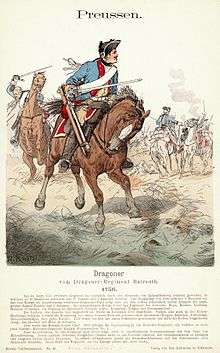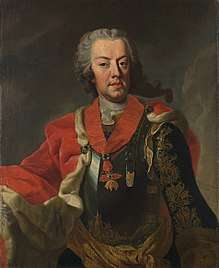Der Hohenfriedberger
"Der Hohenfriedberger" (AM I, 21 (Army March I, 1c and Army march III, 1b)), also called "Hohenfriedberger Marsch" or "Der Hohenfriedberger Marsch", is one of the most classic and well known German military marches. It takes its name from the victory of the Prussians over the allied Austrians and Saxons on June 4, 1745 during the Second Silesian War at the Battle of Hohenfriedberg, near Striegau.
| "Der Hohenfriedberger" | |
|---|---|
| March by possibly Frederick the Great | |
| Catalogue | AM I, 21 |
| Occasion | Commemoration of Battle of Hohenfriedberg (1745) |
| Text | Written for 100th anniversary (1845) |
| Composed | 1795 (piano rendition) |
History
There are many legends surrounding the origins of the march. Supposedly, the Bayreuther dragoon regiment, which was crucial in securing a Prussian victory, reported to its quarters the day after the battle while the march was played. Whether the march was actually played then is just as questionable as the claim that Frederick II of Prussia was the composer of the piece. (The melody appears to be largely derived from The Pappenheimer March, which dates from the early-17th century.) It is understood that the king issued to the Bayreuther dragoon regiment a Gnadenbrief, or "letter of grace", that authorized it to play both grenadier marches of the foot soldiers (with flutes and drums) and the cuirassier marches of the cavalry (with kettledrums and trumpet fanfare).
The first outline (piano rendition) was written in 1795. For the first time in 1845, in celebration of the hundredth anniversary of the battle, the march was given lyrics, "Auf, Ansbach-Dragoner! Auf, Ansbach-Bayreuth!...." because the regiment by then had been renamed "Ansbach-Bayreuth". In the time of the German Kaiser the title "Hohenfriedberger" was symbolic both on the basis of its connection with the great military victories of Friedrich II and because of the authorship of the House of Hohenzollern.
In the year 1866, in commemoration of the victories of Friedrich II against the Austrians, Johann Gottfried Piefke added Der Hohenfriedberger as a trio to his "Königgrätzer Marsch" written after the victorious Battle of Königgrätz.
Lyrics


| Original 1845 commermorative
German lyrics |
English translation |
|---|---|
1st Stanza:
|
1st Stanza:
|
Refrain (2x):
|
Refrain (2x):
|
2nd Stanza:
|
2nd Stanza:
|
Refrain (2x):
|
Refrain (2x):
|
3rd Stanza:
|
3rd Stanza |
Refrain:
|
Refrain:
|
In popular culture
- Mozart based a victory march in his opera Idomeneo on this march.
- In Kubrick's film Barry Lyndon, it was used during the montage scenes depicting Lyndon's service with the Prussian Army during the Seven Years' War. The cavalry version is played while Barry is free and on a horse, and the relentless fife and drum version while he is in the infantry. When he is seconded to the secret police, Mozart's version is played on two occasions.
- The march was used at the beginning of the film Stalingrad (1993) during the rally in Italy before they were sent East.
- In the film "Victory", the march is played by the German Army band prior to "Deutschland Über Alles".
- On a CD released by Brandenburg Historica (2008). "Wohlauf Kameraden". Updated July 20, 2008.
- In the Napoleonic Wars expansion for the video game Mount and Blade: Warband it is one of the tunes the instrumentalists can play for certain team bonuses when playing as the Prussian Army.
See also
- Königgrätzer Marsch
- Yorckscher Marsch
- Badenweiler Marsch
- Alte Kameraden
References
- Refers to Otto Magnus von Schwerin, the regiment's Colonel. He is not to be confused with his contemporary Kurt Christoph, Graf von Schwerin (no relation), the famous Prussian Field Marshal.
- "They" refers to the Austrians, still positioned on the Friedburg Heights above them.
- The uniforms of the allied Austrian and Saxon forces were white, like fresh snow. The speaker is boasting that the close-packed white-coated Austrians would melt away before the Dragoons' charge like a field of springtime snow.
- The Prussian 5th (Bayreuther) Dragoon Regiment (later renamed the Ansbach-Bayreuth Dragoons) destroyed 20 battalions of Austrian and Saxon troops and captured 2,500 prisoners and 67 regimental standards. This forced Prince Charles of Lorraine to retreat.

_-_Google_Art_Project.jpg)